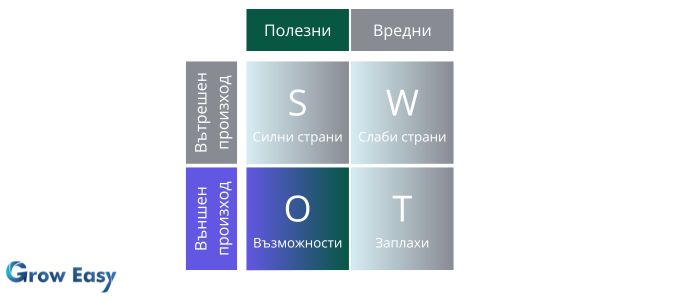In the dynamic environment of business and decision making, a SWOT analysis is a robust framework that offers valuable insight into internal strengths and weaknesses as well as external opportunities and threats.
This guide by Grow Easy Digital Agency will present an in-depth account of the components of SWOT analysis, accompanied by practical examples and explanations to show how and why this methodology should be an integral part of strategic planning.
Table of Contents:
Why is SWOT analysis important?
SWOT analysis - The four components
How to conduct a SWOT analysis?
Practical applications of SWOT analysis
Conclusion
SWOT analysis - what is it?
SWOT analysis is a strategic planning tool. It helps organizations assess their internal strengths and weaknesses. As well as external opportunities and threats in a structured way.
By comprehensively assessing these factors, businesses can develop effective strategies to achieve their goals.

Why is SWOT analysis important?
SWOT analysis gives a clear picture of the current position of the organization and potential opportunities for growth.
It supports informed decision making by highlighting areas that need improvement as well as those that can be used to achieve competitive advantage.
SWOT analysis - The four components
Strengths
Strengths are internal qualities or resourcesthat give the organization advantage ahead of its competitors.
These can range from uniqueskills and valuable assets to an outstanding reputation of brand.
For example, a technology company may have a talented team of software developers. And a local restaurant - with an excellent location in the center of Sofia, which attracts a steady stream of customers.
Recognising strengths allows businesses to capitalise on what they do best.
A tech company can focus on developing practical products, while a restaurant can emphasize its convenient location to attract even more diners.

Weaknesses from SWOT analysis
Weaknesses are internal limitations or disadvantages, that hinder the performance or competitiveness of the organisation.
These may include lack of resources, outdated technology or inefficient processes.
E-commerce businesses may have issues with outdated website design, and healthcare facility may face challenges due to high employee turnover.
By identifying weaknesses, businesses can implement corrective measures. An e-commerce company can invest in a website redesign, and a healthcare facility can focus on improving employee retention strategies.

Opportunities from SWOT analysis
The opportunities are external circumstances or trends, that can be used for the benefit of the organisation.
They may arise as a result of market changes, technological advances or changing consumer behaviour.
A software company may spot the growing need for cybersecurity solutions, and a renewable energy start-up may benefit from the growing demand for eco-friendly alternatives.
Seizing opportunities requires strategic action.
A software company might develop a suite of cybersecurity products, and a renewable energy startup might focus on innovative marketing campaigns to attract environmentally conscious consumers.

Threats
The threats are external factors, that could potentially harm the organisation's prospects.
These may include actions by competitors, economic downturns or regulatory changes.
A retail chain may face the threat of online competitors, while a travel company may be vulnerable to sudden changes in people's attitudes towards travel.
Addressing threats involves developing contingency plans.
The retail chain can invest in its online presence and the travel company can diversify its offerings to cater to different types of travelers.

How to conduct a SWOT analysis?
Step 1: Identify internal factors (strengths and weaknesses)
Start by assessing your organization's internal capabilities and constraints.
Gather input from employees, stakeholders and analyze the data to determine where you excel and where you fall short.
Step 2: Identify external factors (opportunities and threats)
Study the external environment to identify potential opportunities and threats.
Analyze market trends, the competitive environment, and regulatory changes that could impact your organization.
Step 3: Combined consideration of factors
Draw connections between internal and external factors to discover strategic insights.
For example, pair a strength (strong brand reputation) with an opportunity (growing demand for your product) to identify potential areas of growth.
Step 4: Formulate strategies based on SWOT analysis
Use the information derived from the SWOT analysis to develop actionable strategies.
Take advantage of strengths and opportunities. While addressing weaknesses and mitigating threats to position your organization for success.

Practical applications of SWOT analysis
SWOT analysis guides long-term business strategies, by helping organisations align their strengths and capabilities with mission, vision and market trends.
By combining their strengths with market opportunities, businesses can create innovative products, that meet customer requirements more effectively.
SWOT analysis also assists marketing campaigns by identifying unique selling points (strengths), potential niche markets (opportunities) and areas for improvement (weaknesses).
Хората могат да използват SWOT анализа, за да оценят своите умения, слаби страни, възможности и потенциални заплахи и да вземат информирани решения за своята кариера.
Tips for effective SWOT analysis
Joint participation
Involve a diverse group of stakeholders to gather different perspectives and create a well-grounded analysis.
Objective assessment
Conduct the analysis objectively, focusing on real data and evidence rather than assumptions.

Regular review and adaptation
The business environment is dynamic. Regularly review and update your SWOT analysis to stay current and adaptable.
Real world examples
Company A: Maintaining competitiveness
A retail company recognizes the threat of online competition (external threat) and identifies its weak online presence (internal weakness). A strategy was developed to invest in e-commerce capabilities (addressing the weakness) and innovative online marketing campaigns were launched (leveraging strengths and opportunities) to remain competitive.

Individual application: quarry construction
The person appreciates their strong analytical skills (a strength) and identifies the growing demand for data analysts (an external opportunity). To maximize his career prospects, he enrolled in appropriate courses to address skill gaps (addressing weaknesses), and acquired certifications to stand out (leveraging strengths and opportunities).
Conclusion
SWOT analysis is a powerful tool that gives organizations and individuals the information needed to make strategic decisions. By carefully assessing internal strengths and weaknesses as well as external opportunities and threats, informed strategies can be formulated to achieve goals and effectively address challenges.

0 коментара